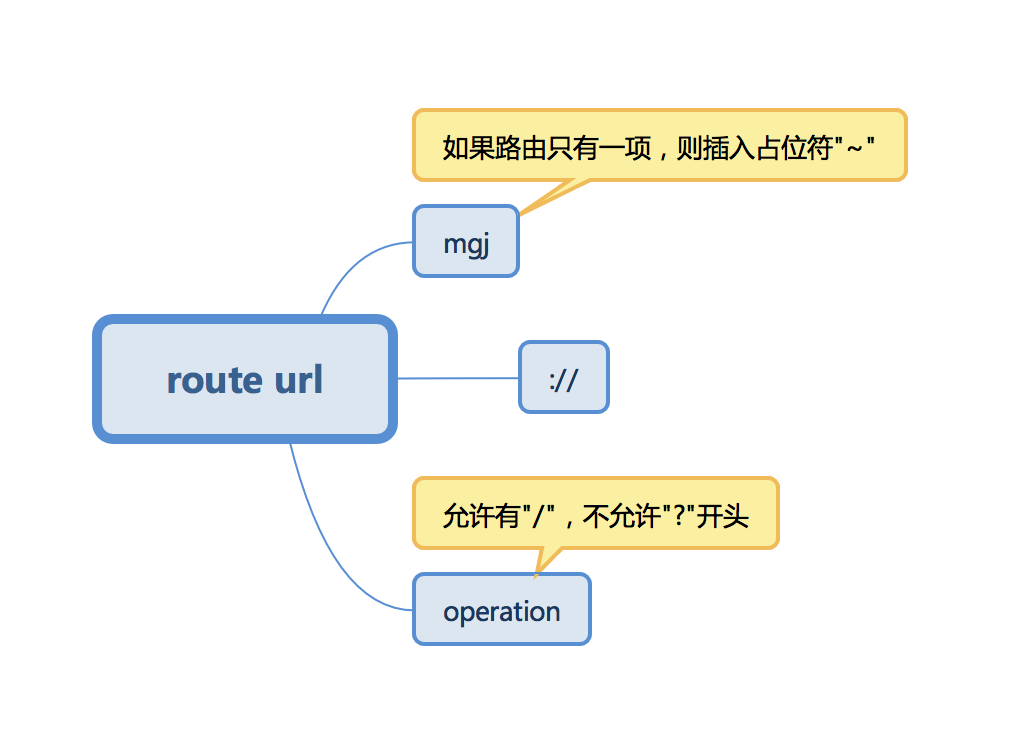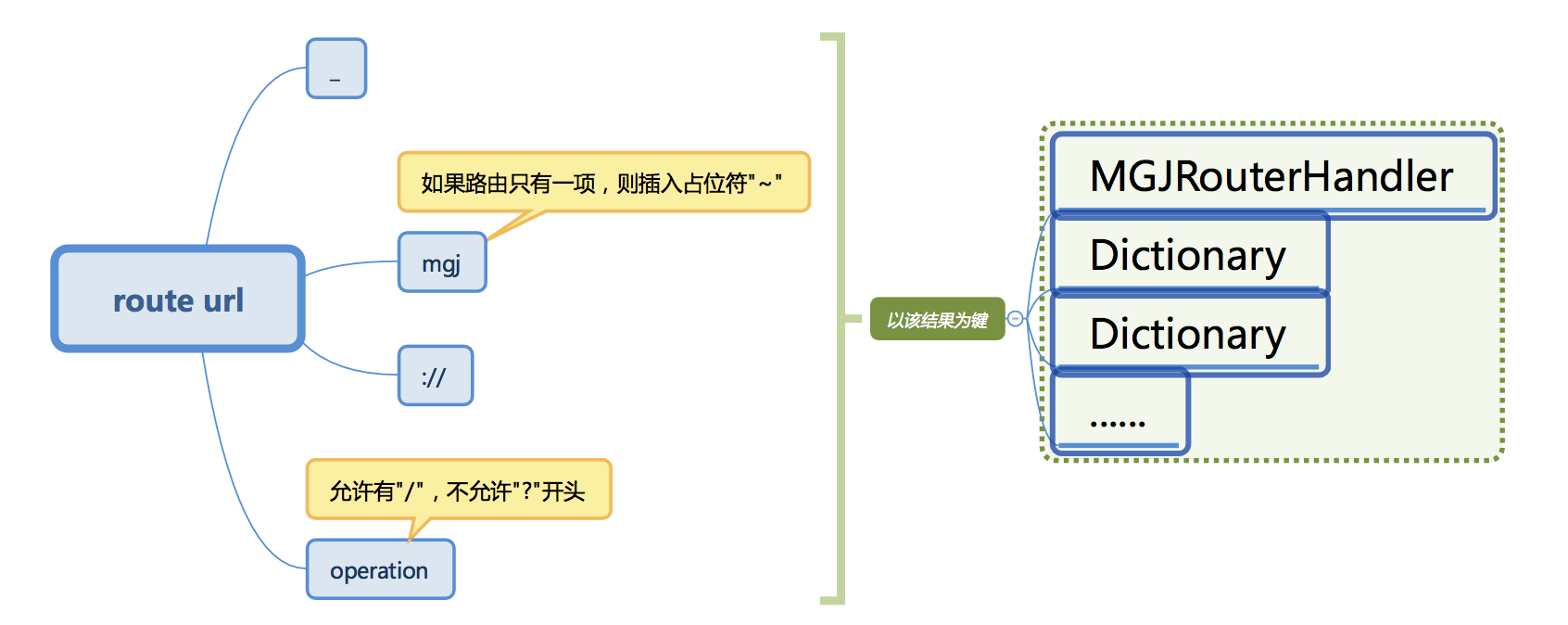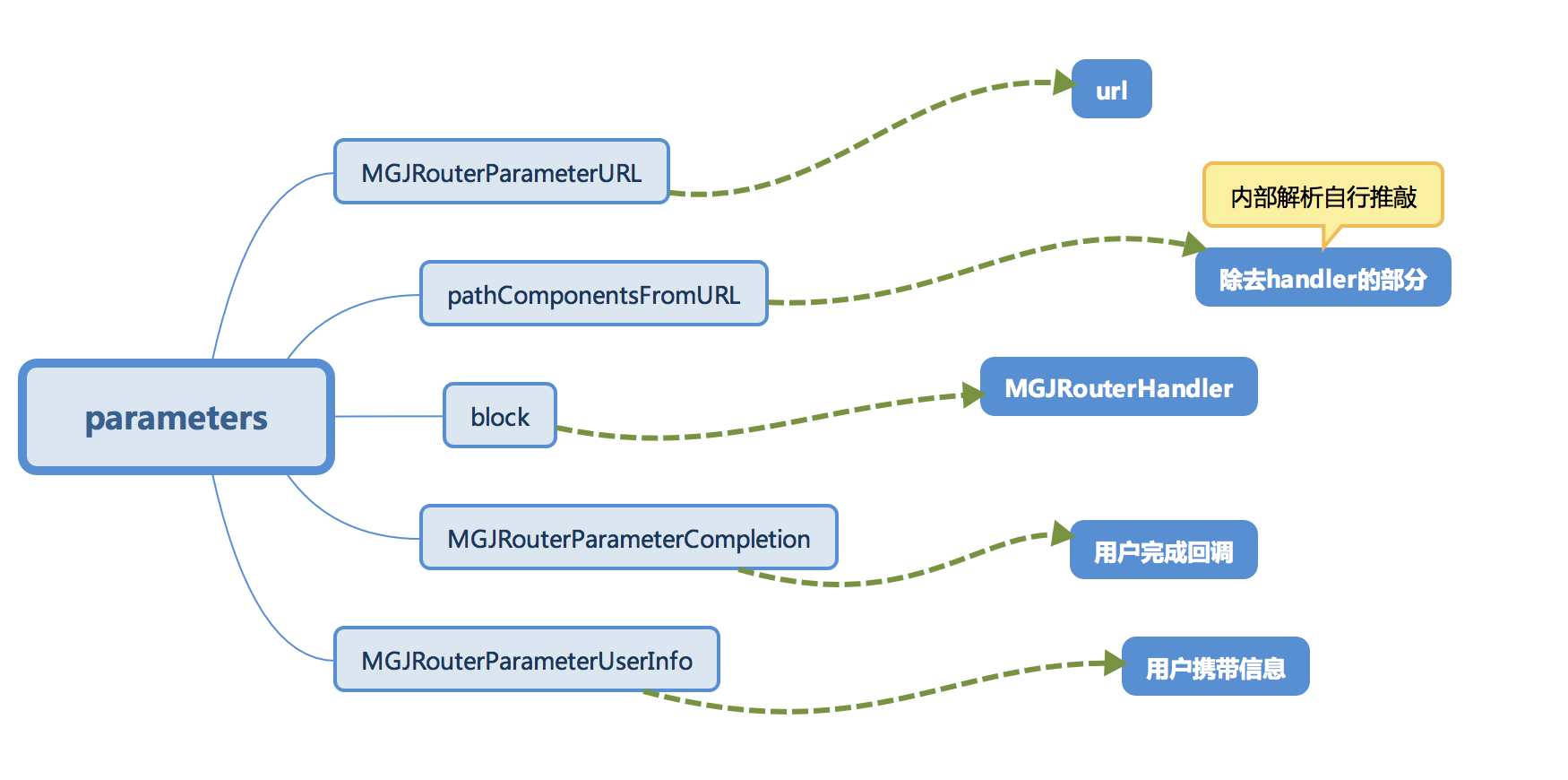今天来聊聊组件化,之前一直听说大厂在搞,什么淘宝架构,什么蘑菇街,既然谈到了架构的问题,那必属重中之重。接下来分析一下蘑菇街开源的代码,自己做个总结。
引入
类书本的文章个人感觉还是写不来的,再搬到自己写的东西这来也不合适,所以直接上一链接,通过链接文章大致可了解下它的前身后世,产生原因,以及整体宏观架构设计,而我接下来要做的是细化,以及转化,便于自己吸收 ---------> 组件化架构漫谈
1. 话不多说,先看入口:
 image_1c25qj3m5ejq111g1v5lvkgjek9.png-7.7kB
image_1c25qj3m5ejq111g1v5lvkgjek9.png-7.7kB
@interface MGJRouter ()
/**
* 保存了所有已注册的 URL
* 结构类似 @{@"beauty": @{@":id": {@"_", [block copy]}}}
*/
@property (nonatomic) NSMutableDictionary *routes;
@end
+ (instancetype)sharedInstance
{
static MGJRouter *instance = nil;
static dispatch_once_t onceToken;
dispatch_once(&onceToken, ^{
instance = [[self alloc] init];
});
return instance;
}
很明显,蘑菇街架构(以下简称MGJ)通过该单例作管理,统一进行调配,而该单例仅有一个变量,就是routes,实际上它仅仅是管理了一个字典的结构,具体字典内有哪些内容,我们慢慢看;
2. 回调Block的定义
/**
* routerParameters 里内置的几个参数会用到上面定义的 string
*/
typedef void (^MGJRouterHandler)(NSDictionary *routerParameters);
/**
* 需要返回一个 object,配合 objectForURL: 使用
*/
typedef id (^MGJRouterObjectHandler)(NSDictionary *routerParameters);
上面这两个block定义是MGJ注册URL的回调,一个带返回值,另一个不带,在这里我们说一下带返回值的block用法;如下举例 ------>
 WX20180107-134538@2x.png-37.5kB
WX20180107-134538@2x.png-37.5kB
//声明
typedef UIViewController *(^ViewControllerHandler)();
//作参数
@interface DemoListViewController : UIViewController
+ (void)registerWithTitle:(NSString *)title handler:(ViewControllerHandler)handler;
@end
//定义
@implementation DemoListViewController
+ (void)registerWithTitle:(NSString *)title handler:(ViewControllerHandler)handler
{
UIViewController* vc = handler()
}
@end
//在别处调用
@implementation DemoDetailViewController
[DemoListViewController registerWithTitle:@"基本使用" handler:^UIViewController *{
return DemoDetailViewController();
}];
@end
如上,我们把ViewControllerHandler的运行延迟到了实际调用的时刻,并且我们可以在这个handler的实现中带入很多信息;
3. MGJ数据结构管理
extern NSString *const MGJRouterParameterURL;
extern NSString *const MGJRouterParameterCompletion;
extern NSString *const MGJRouterParameterUserInfo;
//*************************************************
static NSString * const MGJ_ROUTER_WILDCARD_CHARACTER = @"~"; //这是一个占位符
static NSString *specialCharacters = @"/?&.";
NSString *const MGJRouterParameterURL = @"MGJRouterParameterURL";
NSString *const MGJRouterParameterCompletion = @"MGJRouterParameterCompletion";
NSString *const MGJRouterParameterUserInfo = @"MGJRouterParameterUserInfo";
从这里我们可以看出,MGJ的路由管理,实际上是一个解析url以及对应的管理,我们举几个URL来看一下:
@"mgj://"
@"mgj://foo/bar/none/exists"
@"mgj://foo/bar"
@"mgj://category/家居"
@"mgj://category/travel"
@"mgj://search/:query"
@"mgj://detail"
@"mgj://search/:keyword"
@"mgj://search_top_bar"
通过上面的URL我们可以看出,路由的管理实际上就是url的解析过程,下面我们来具体看一下解析过程;
4. URL解析
- route url
 WX20180107-150437@2x.png-59.1kB
WX20180107-150437@2x.png-59.1kB
- (NSArray*)pathComponentsFromURL:(NSString*)URL
{
NSMutableArray *pathComponents = [NSMutableArray array];
if ([URL rangeOfString:@"://"].location != NSNotFound) {
NSArray *pathSegments = [URL componentsSeparatedByString:@"://"];
// 如果 URL 包含协议,那么把协议作为第一个元素放进去
[pathComponents addObject:pathSegments[0]];
// 如果只有协议,那么放一个占位符
URL = pathSegments.lastObject;
if (!URL.length) {
[pathComponents addObject:MGJ_ROUTER_WILDCARD_CHARACTER];
}
}
for (NSString *pathComponent in [[NSURL URLWithString:URL] pathComponents]) {
if ([pathComponent isEqualToString:@"/"]) continue;
if ([[pathComponent substringToIndex:1] isEqualToString:@"?"]) break;
[pathComponents addObject:pathComponent];
}
return [pathComponents copy];
}
-
key-value
 WX20180107-151956@2x.png-111.8kB
WX20180107-151956@2x.png-111.8kB
- (NSMutableDictionary *)addURLPattern:(NSString *)URLPattern
{
NSArray *pathComponents = [self pathComponentsFromURL:URLPattern];
NSMutableDictionary* subRoutes = self.routes;
for (NSString* pathComponent in pathComponents) {
if (![subRoutes objectForKey:pathComponent]) {
subRoutes[pathComponent] = [[NSMutableDictionary alloc] init];
}
subRoutes = subRoutes[pathComponent];
}
return subRoutes;
}
- 核心url解析
 WX20180107-160319@2x.png-147.8kB
WX20180107-160319@2x.png-147.8kB
- (NSMutableDictionary *)extractParametersFromURL:(NSString *)url
{
NSMutableDictionary* parameters = [NSMutableDictionary dictionary];
parameters[MGJRouterParameterURL] = url;
NSMutableDictionary* subRoutes = self.routes;
NSArray* pathComponents = [self pathComponentsFromURL:url];
BOOL found = NO;
// borrowed from HHRouter(https://github.com/Huohua/HHRouter)
for (NSString* pathComponent in pathComponents) {
// 对 key 进行排序,这样可以把 ~ 放到最后
NSArray *subRoutesKeys =[subRoutes.allKeys sortedArrayUsingComparator:^NSComparisonResult(NSString *obj1, NSString *obj2) {
return [obj1 compare:obj2];
}];
for (NSString* key in subRoutesKeys) {
if ([key isEqualToString:pathComponent] || [key isEqualToString:MGJ_ROUTER_WILDCARD_CHARACTER]) {
found = YES;
subRoutes = subRoutes[key];
break;
} else if ([key hasPrefix:@":"]) {
found = YES;
subRoutes = subRoutes[key];
NSString *newKey = [key substringFromIndex:1];
NSString *newPathComponent = pathComponent;
// 再做一下特殊处理,比如 :id.html -> :id
if ([self.class checkIfContainsSpecialCharacter:key]) {
NSCharacterSet *specialCharacterSet = [NSCharacterSet characterSetWithCharactersInString:specialCharacters];
NSRange range = [key rangeOfCharacterFromSet:specialCharacterSet];
if (range.location != NSNotFound) {
// 把 pathComponent 后面的部分也去掉
newKey = [newKey substringToIndex:range.location - 1];
NSString *suffixToStrip = [key substringFromIndex:range.location];
newPathComponent = [newPathComponent stringByReplacingOccurrencesOfString:suffixToStrip withString:@""];
}
}
parameters[newKey] = newPathComponent;
break;
}
}
// 如果没有找到该 pathComponent 对应的 handler,则以上一层的 handler 作为 fallback
if (!found && !subRoutes[@"_"]) {
return nil;
}
}
// Extract Params From Query.
NSArray<NSURLQueryItem *> *queryItems = [[NSURLComponents alloc] initWithURL:[[NSURL alloc] initWithString:url] resolvingAgainstBaseURL:false].queryItems;
for (NSURLQueryItem *item in queryItems) {
parameters[item.name] = item.value;
}
if (subRoutes[@"_"]) {
parameters[@"block"] = [subRoutes[@"_"] copy];
}
return parameters;
}
+ (void)openURL:(NSString *)URL withUserInfo:(NSDictionary *)userInfo completion:(void (^)(id result))completion
{
URL = [URL stringByAddingPercentEscapesUsingEncoding:NSUTF8StringEncoding];
NSMutableDictionary *parameters = [[self sharedInstance] extractParametersFromURL:URL];
[parameters enumerateKeysAndObjectsUsingBlock:^(id key, NSString *obj, BOOL *stop) {
if ([obj isKindOfClass:[NSString class]]) {
parameters[key] = [obj stringByReplacingPercentEscapesUsingEncoding:NSUTF8StringEncoding];
}
}];
if (parameters) {
MGJRouterHandler handler = parameters[@"block"];
if (completion) {
parameters[MGJRouterParameterCompletion] = completion;
}
if (userInfo) {
parameters[MGJRouterParameterUserInfo] = userInfo;
}
//所以注册路由时的回调是在这里才调用到的
//也就是openURL响应了register的回调
if (handler) {
[parameters removeObjectForKey:@"block"];
handler(parameters);
}
}
}
5. 后续?













网友评论